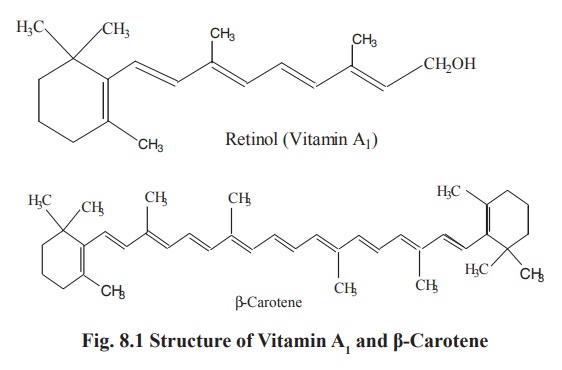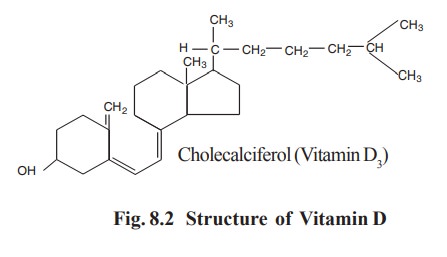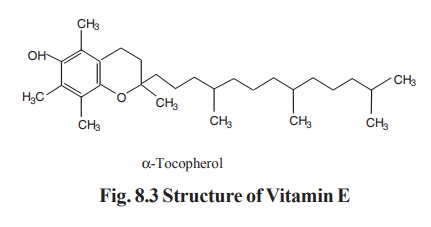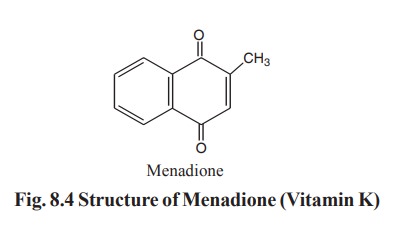Chapter: Biochemistry: Vitamins
Fat soluble vitamins
Classification
Vitamins are generally classified into two main
groups. (i) fat soluble vitamins (ii) water soluble vitamins.
1. Fat soluble vitamins
The members of this group are A,D,E and K. All
these vitamins are not soluble in water and readily soluble in fat dissolving
organic solvents. Inside the body for their transport and metabolism they need
the presence of fats.
i. Vitamin - A
Vitamin A is found only in foods of animal
origin. It is present in almost all species of fish, birds and mammals. The
yellow plant pigments α, β and γ carotenes and cryptoxanthin are
precursors of vitamin A. The body has the ability to convert these carotenoid
compounds present in the diet into vitamin A.
The chemical structure of β - carotene is such that it oxidizes to form two molecules of
vitamin A, the other provitamins form only one. b-carotene is more efficiently converted to
vitamin A than α - or γ - carotene or cryptoxanthin.
There are two forms of vitamin A: Vitamin A1
which occurs in the liver of marine water fish and Vitamin A2 found
in the liver of fresh water fish. The vitamin A which contain alcoholic group
in the side chain is called as retinol (Fig. 8.1) and which contain aldehyde
group is known as retinal. Though the two vitamins differ slightly in their
chemical structures their physiological functions are the same.

Functions
Vitamin A is essential
·
for the
growth and metabolism of all body cells
·
for the
formation of rhodopsin (visual purple) a complex substance formed from retinol
and protein. Rhodopsin, a pigment found in retina is necessary for vision in
dim light.
·
for the
maintenance of healthy skin, particularly mucous membrane of the cornea and the
lining of respiratory tract.
Sources
The liver of any animal is a rich source of
vitamin A. Fish liver oil is an excellent source. Whole milk, egg yolk, dark
green leafy vegetables and deep yellow vegetables and fruits are rich in
carotenes, which can be converted into vitamin A by the intestinal wall.
Requirements
Vitamin A requirement is based on the intake to
maintain the normal blood level. Adults placed on a vitamin A free diet are
found to show no change in the level for several weeks.The capacity of the body
to store vitamin A provides for an effective emergency supply. Recommended
amount of Vitamin A for different age group is as follows:
Infants - 1500 IU / day
Children - 2000-3000 IU / day
Adults Pregnant and - 5000 IU / day
lactating women - 6000-8000 IU / day (IU = International units)
Absorption and storage
Vitamin A and carotene are absorbed from the
small intestine into the lymph system. The maximum absorption is reached 3 to 5
hours after consumption. The rate of absorption of vitamin A is more rapid than
that of carotene. In the human being about 95% of the vitamin A stored in the
body is found in the liver with small amount in the lungs, adipose tissue and
kidneys.
Deficiency
The earliest sign of vitamin A deficiency is
concerned with vision. Initially there is a loss of sensitivity to green light,
followed by impairment to adapt to dim light. This condition leads to night blindness. More prolonged or
severe deficiency leads to the ulceration of cornea and this condition is known
as xerophthalmia or keratomalacia.
ii.Vitamin D
There are two distinct forms of Vitamin D
Cholecalciferol (Vitamin D3) is the
natural form of the vitamin occurring in foods (Fig. 8.2). It can be formed
under the skin from 7 dehydro cholesterol by the influence of sun light (ultra
violet (UV) radiation)
Ergo calciferol (vitamin D2) is a
synthetic form of the vitamin which has the same activity as the natural
vitamin. It is produced by the UV radiation of ergo sterol, a compound which
can be extracted from yeast. This is the form of vitamin which is added to
commodities such as margarine and baby foods.

Functions
Vitamin D is necessary for the growth and
maintenance of bones and teeth. Vitamin D helps in the absorption of calcium
and phosphorus from the small intestine and for the uptake of calcium and
phosphorus by the bones and teeth.
Sources
Vitamin D is not widely distributed in nature
and the best sources are fish oil, especially liver oil. Milk, butter and egg
yolk are the only foods in the ordinary diet that contain vitamin D.
Requirements
It is difficult to make standard recommendations
for the dietary requirements of vitamin D since the amount of vitamin D
produced in the body by the action of sunlight varies from person to person.
Many people may obtain this vitamin from sunlight. It is, however certain that
babies and growing children require more vitamin D than adults, due to rapid
growth and bone development.
Infants and children - 400 IU / day
Adults - 200 IU / day
Pregnant and lactating women - 400 IU/day
Absorption and storage
Fat helps in the absorption of vitamin D and
bile is essential for its absorption. Vitamin D enters into the general
circulation via lymph and stored largely in liver and kidneys.
Deficiency
Children receiving an inadequate supply of
vitamin D develop rickets. Calcium
and phosphorus are inadequately deposited in the bones. Premature infants are
more susceptible to rickets than full term infants. In adults on inadequate
supply of vitamin D causes osteomalacia,
a condition in which the bones become soft, weak and painful.
iii. Vitamin E
Vitamin E activity is possessed by a number of
compounds known as tocopherols. Among these compounds α-tocopherol is known as
vitamin E. Structurally vitamin E contains a dihydro benzopyran nucleus with an
isoprenoid side chain (Fig. 8.3). Many of them are pale yellow oils soluble in
fat.

Functions
The principal role of vitamin E appears to be
as an antioxidant. By accepting oxygen, vitamin E can prevent the oxidation of
vitamin A in the intestinal tract, thus making vitamin A available for body
use. Vitamin E also reduces the oxidation of the poly unsaturated fatty acids,
thereby helping to maintain normal cell membrane. It protects the red blood
cells against hemolysis. Vitamin E is required by animals, and presumably, by
humans for the normal reproductive processes. It also plays an important
protective role during ageing of cells.
Sources
Wheat germ oil and corn germ oil are the rich
natural sources. Vegetable oils and fats are good sources. Cereals and animal
foods are fair sources of tocopherol.
Requirements
It is difficult to establish vitamin E
requirements. The requirement depends mainly on the intake of poly unsaturated
fatty acids. It is generally accepted that the intake of vitamin E should be
0.4 mg α -tocopherol equivalents / g dietary poly unsaturated fatty acid. This
does not present any problem, since all foods which are rich sources of poly
unsaturated fatty acids are also rich sources of vitamin E.
There is some evidence that higher intake of
vitamin E may have a useful protective effect against the development of
ischaemic heart disease. This is because high concentrations of vitamin E
inhibit the oxidation of poly unsaturated fatty acids in plasma lipoproteins
and this oxidation which is responsible for the initiation of atherosclerosis
(deposition of fat in the coronory artery walls). The levels that appear to be
beneficial are of the order of 17-40 mg α -tocopherol/day, which is above what
could be achieved by eating ordinary foods.
Adults : 25 - 30 mg / day
Absorption and storage
Vitamin E, like other fat soluble vitamins, is
absorbed along with fat in the intestines.
It is stored in the liver, muscle and body fat.
Deficiency
Vitamin E deficiency cause the following
disorders in animals.
Reproductive failure
Hemolysis of red blood cells
Muscular dystrophy
iv. Vitamin K
Vitamin K is known as the antihemorrhagic
vitamin.
Three compounds which have the biological
activity of vitamin K are
1.
Phylloquinone,
which is the normal dietary source, being found in green leafy vegetables.
2.
Menaquinones,
which are a family of closely related compounds synthesized by the intestinal
bacteria, with differing lengths of the side chain.
3.
Menadione,
a synthetic compound which can be metabolised to yield phylloquinone (Fig 8.4).

Functions
Vitamin K is needed for the formation of
prothrombin, a substance necessary for blood clotting.
Intestinal bacteria normally synthesize
substantial amount of vitamin K. Because vitamin K is fat soluble, its
absorption is facilitated in the presence of bile. Small amount of vitamin k
are stored in the liver, heart, skin, muscle and kidneys.
Sources
The best source of vitamin K are the green
leafy vegetables eg. spinach, cabbage, kale etc. Good sources are cauliflower,
wheat germ, etc. Carrots and potatos are fair sources. Milk, meat and fish are
poor sources.
Requirements
Vitamin K requirement depends on the amount of
vitamin K formed by the intestinal bacteria. The more the endogenous vitamin K
formation less will be the dietary requirement.
Absorption and storage
Being fat-soluble, its absorption is enhanced
by sufficient amount of bile salts mainly in the jejunum by the way of
lymphatics. Liver stores appreciable amounts. It is present in blood stream in
significant amount. All tissues contain small amounts of vitamin K.
Deficiency
The deficiency of vitamin K leads to a lowering
of prothrombin level and increased clotting time of blood. This may lead to
hemorrhagic conditions. Vitamin K deficiency causes hemorrhagic disease of the
newborn.
Related Topics